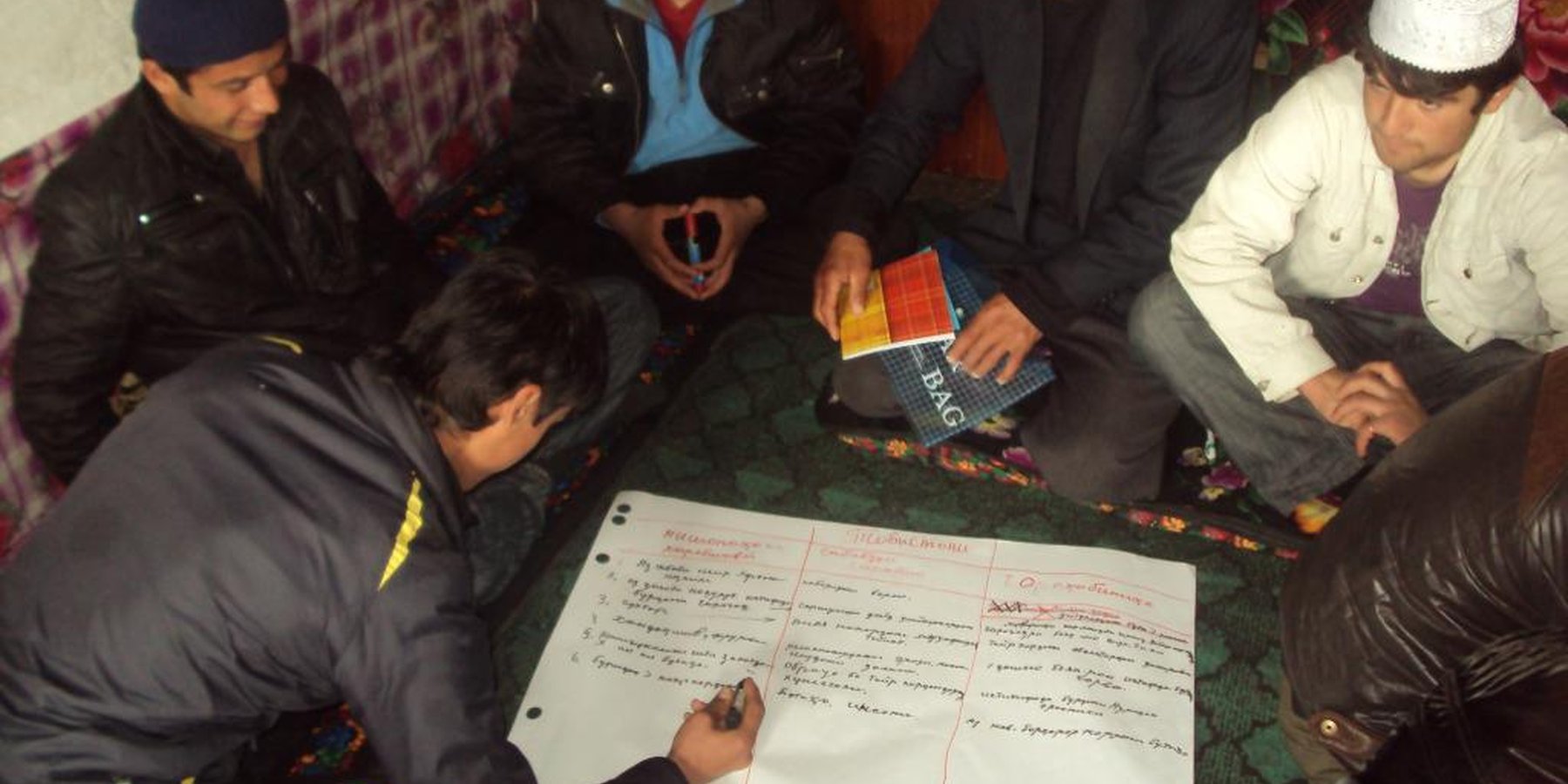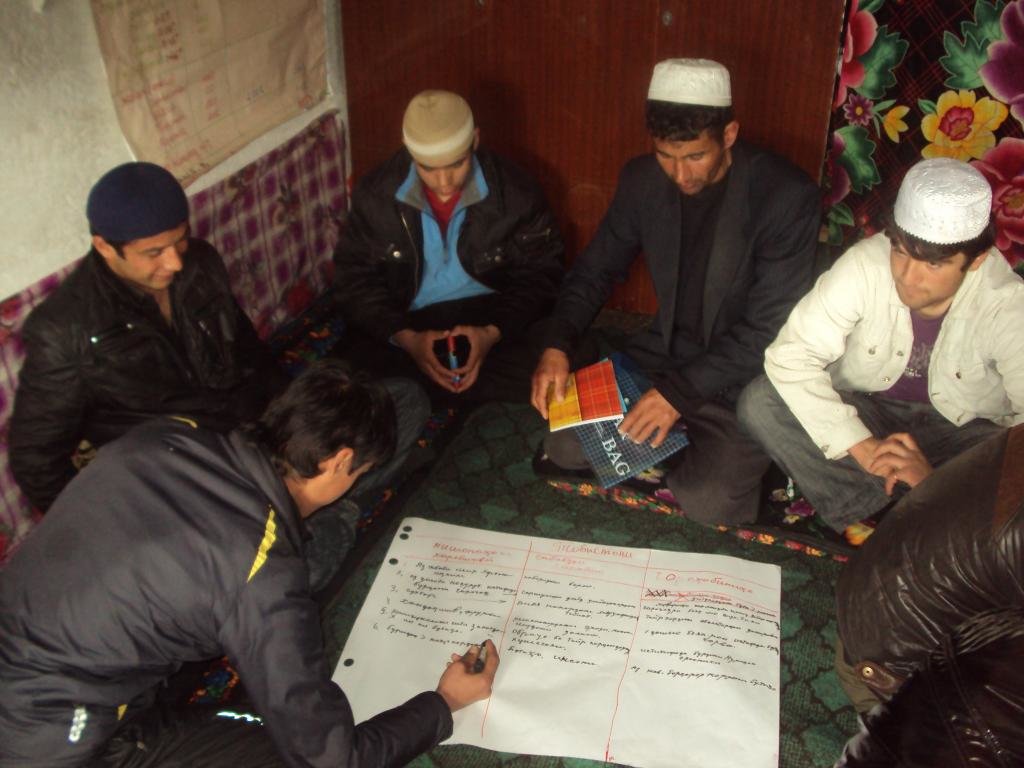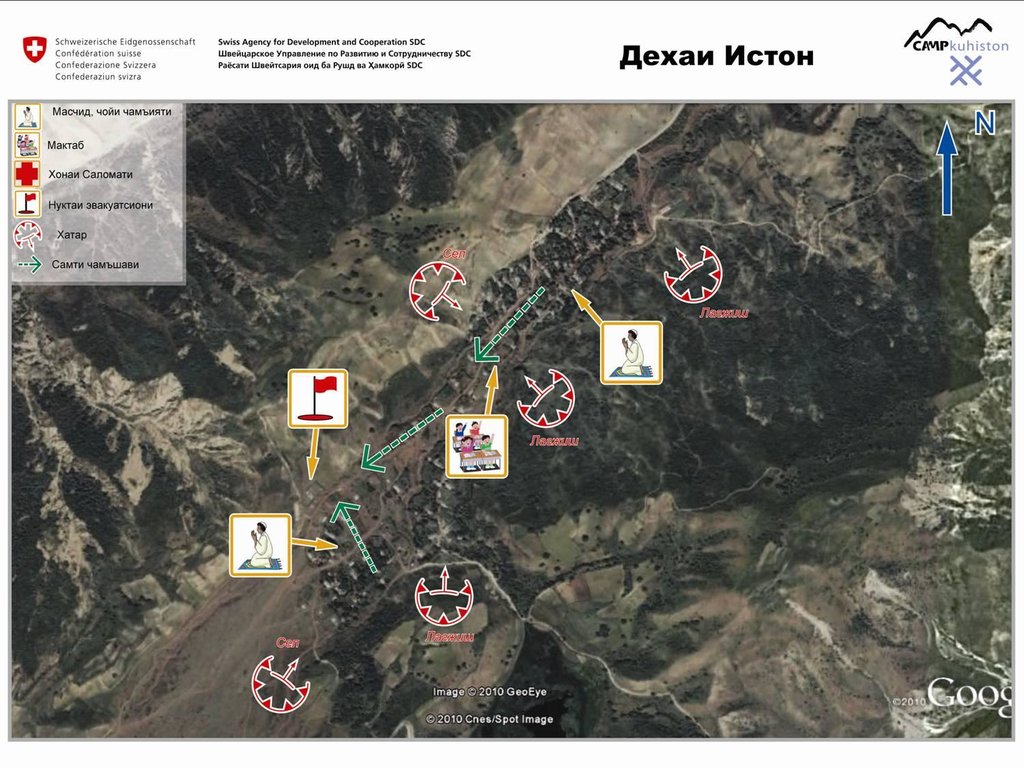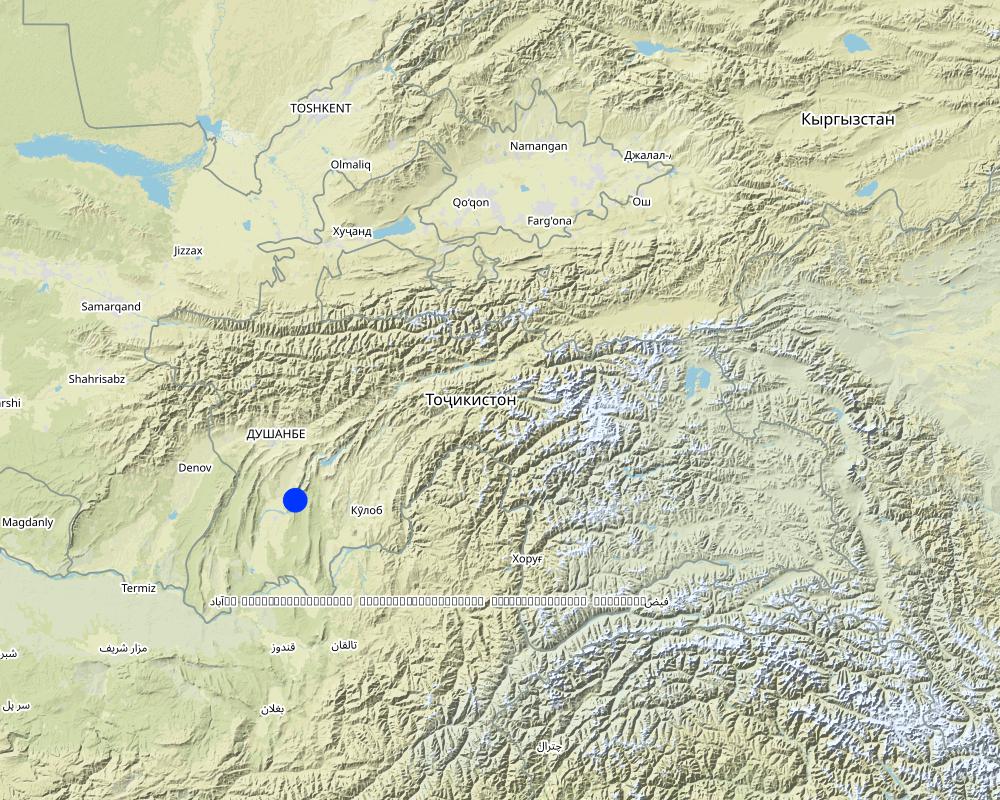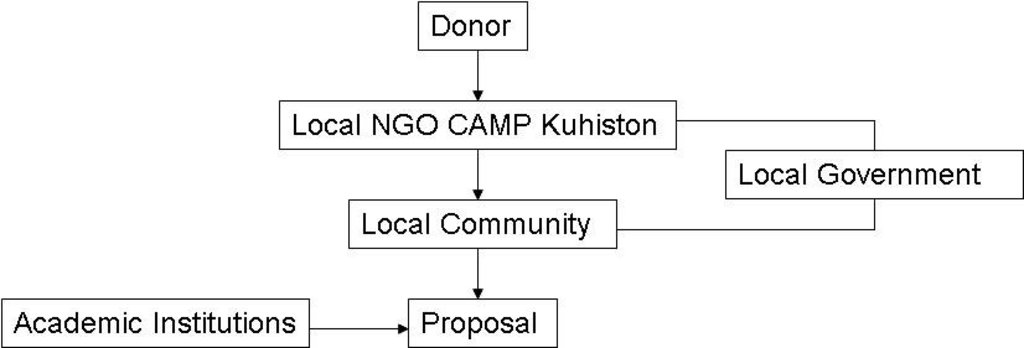Selection of SLM Technologies for Natural Disaster Risk Mitigation [Tadjikistan]
- Création :
- Mise à jour :
- Compilateur : shane stevenson
- Rédacteur : –
- Examinateurs : David Streiff, Alexandra Gavilano, Joana Eichenberger
CAMP Kuhiston
approaches_2437 - Tadjikistan
Voir les sections
Développer tout Réduire tout1. Informations générales
1.2 Coordonnées des personnes-ressources et des institutions impliquées dans l'évaluation et la documentation de l'Approche
Spécialiste GDT:
Spécialiste GDT:
Pocheov Mirzokubon
+992 44 601 55 05
CAMP Kuhiston
Rudaki avenue, Dushanbe
Tadjikistan
Nom du projet qui a facilité la documentation/ l'évaluation de l'Approche (si pertinent)
Pilot Program for Climate Resilience, Tajikistan (WB / PPCR)Nom du ou des institutions qui ont facilité la documentation/ l'évaluation de l'Approche (si pertinent)
CAMP - Central Asian Mountain Partnership (CAMP - Central Asian Mountain Partnership) - KirghizistanNom du ou des institutions qui ont facilité la documentation/ l'évaluation de l'Approche (si pertinent)
CDE Centre for Development and Environment (CDE Centre for Development and Environment) - Suisse1.3 Conditions relatives à l'utilisation par WOCAT des données documentées
Quand les données ont-elles été compilées (sur le terrain)?
10/06/2011
Le compilateur et la(les) personne(s) ressource(s) acceptent les conditions relatives à l'utilisation par WOCAT des données documentées:
Oui
1.4 Références au(x) questionnaire(s) sur les Technologies de GDT
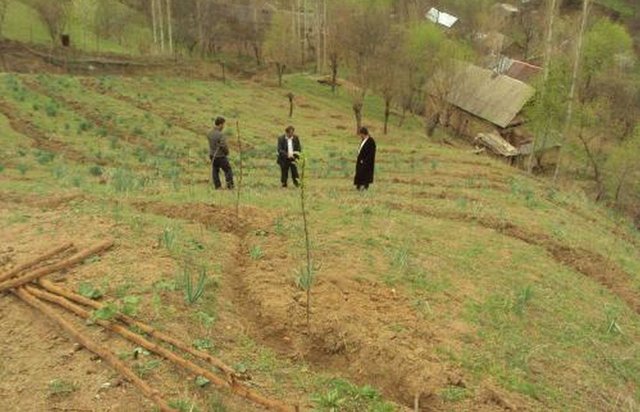
Planting of fruit trees to increase slope stabilisation [Tadjikistan]
Planting fruit tree orchards to increase the stability of the steep loess soil slopes.
- Compilateur : Gulniso Nekushoeva
2. Description de l'Approche de GDT
2.1 Courte description de l'Approche
Community Based Natural Disaster Risk Management Workshops for identification of locations for the implementation of SLM technology to reduce the risk to the village from natural disasters.
2.2 Description détaillée de l'Approche
Description détaillée de l'Approche:
Aims / objectives: The main objective was to use a community based participatory approach to evaluate the risk from natural hazards and aid in the effective selection of location and types of SLM Technologies that could be implemented. The workshop systematically works through the natural disaster risk assessment process which includes evaluation of the natural and human triggers that can causes and contribute to specific natural disasters and subsequently rank the risk as either high/medium/low based upon a predetermined criteria. The assessment is repeated with the assumption the SLM mitigation has been implemented to evaluate whether the natural disaster risk would be reduced.
Methods: Several methodologies are used in this approach, these include the, display of posters and photos, watching documentary style DVD’s, playing awareness raising training games, and distribution of brochures to educate the communities on the causes and impacts of natural disasters so that they can then complete a systematic risk assessment process. This is undertaken within the community using interactive participatory training modules and experienced teachers. Once the technologies are decided upon a proposal form is completed and copies submitted to funding agencies and the local government. A Memorandum of Understanding is signed with the local government to endorse the approach and any subsequent implementation activities. The proposal is vetted by experts for modification and approval to ensure best practice and sustainable results.
Stages of implementation: The communities are selected based upon natural disaster statistics and a natural disaster workshop conducted for up to twenty members of the community. At the completion of the workshop the community produce several proposals for the implementation of SLM technologies that will reduce the risk from specific natural disasters. The proposals are reviewed by experts from the soil institute and horticulture institute to ensure they are practical, viable and effective before final submission to the donor for funding. The local government remains informed of the activities throughout the process and is provided with copies of the proposals.
Role of stakeholders: NGO CAMP Kuhiston were the overall project managers. CAMP designed and conducted training on Disaster Risk Reduction and developed the natural hazard risk assessment process that leads to the formulation of the SLM mitigation proposals. CAMP are also responsible for engaging the experts and providing information to the local government who are asked to support the process. The community has to actively be involved and design their own proposal and decide how they will contribute to the implementation process.
Other important information: Although this could potentially be a lengthy process it is important that the communities understand why they have chosen a specific SLM technology and the desired impact that will help secure their livelihoods.
2.3 Photos de l'approche
2.5 Pays/ région/ lieux où l'Approche a été appliquée
Pays:
Tadjikistan
Région/ Etat/ Province:
RRS
Autres spécifications du lieu :
Nurabad
Commentaires:
SLM was implemented in 7 different locations covering 5 villages within Mujiharf and Hakimi jamoats of Nurabad District. The two main watersheds are shown in the googleEarth file.
Map
×2.6 Dates de début et de fin de l'Approche
Indiquez l'année de démarrage:
2009
Date (année) de fin de l'Approche (si l'Approche n'est plus appliquée):
2011
2.7 Type d'Approche
- fondé sur un projet/ programme
2.8 Principaux objectifs de l'Approche
The Approach focused mainly on SLM with other activities (Natural Disaster Risk Mitigation)
The main objective was to educate the communities on the causes and triggers of natural disasters and how these triggers can be combated by SLM technologies. The approach concentrated on making the link between SLM technologies and causes of natural disasters. The risk assessment process helped communities understand how to evaluate the risk to their community from different types natural disasters and how these proposals would help reduce the risk presented by these types of natural disasters and also where is was the most effective and efficient use of time, finance and resources to reduce this risk.
The SLM Approach addressed the following problems: The stabilisation of degraded slopes that increased the risk to communities from natural disaster such as mud flows, landslides, and avalanches.
2.9 Conditions favorisant ou entravant la mise en œuvre de la(des) Technologie(s) appliquée(s) sous l'Approche
normes et valeurs sociales/ culturelles/ religieuses
- entrave
There were major problems incorporating women into the initial disaster risk management workshops and trainings. Therefore, there was limited input into the mitigation proposal development process.
Treatment through the SLM Approach: In some villages workshops were held separately from the men using female trainers. However, due to low educational backgrounds there was a limited the level of participation. The field training during the implementation stage managed to capture the women
disponibilité/ accès aux ressources et services financiers
- entrave
There was initial concern that the farmers would not have finance to maintain the technology in the first year. The project was also conscious that fruit trees are subject to tax after three years.
Treatment through the SLM Approach: Farmers were provided with a minimal payment at different stages as the SLM technology developed.
cadre institutionnel
- entrave
The Jamoat wanted to have more say in the land owners who received the trees.
Treatment through the SLM Approach: The Jamoat were taken on site visits and were explained that the land was selected because of the hazard risk, not the land owner.
cadre juridique (régime foncier, droits d'utilisation des terres et de l'eau)
- entrave
There was no formal documentation to show who was the owner of the land.
Treatment through the SLM Approach: There was an informal agreement between the land user, village members and jamoat.
The existing land ownership, land use rights / water rights moderately hindered the approach implementation Although there are land use certificates available for farms, there are problems with allocating specific parcels of land to one particular land user. Therefore this issue needs to resolved before a technology can be implemented.
3. Participation et rôles des parties prenantes impliquées dans l'Approche
3.1 Parties prenantes impliquées dans l'Approche et rôles
- exploitants locaux des terres / communautés locales
Five local communities (20 people per community)
Individual land users were involved in workshops and planning of SLM Technology
Community were involved in workshops
Women particpitaed less, since there are noticeable gaps in the education levels of the genders and women fulfill a more traditional role centered around the household.
This area suffers from high levels of labour migration with many of the men working abroad in countries such as Russia. In particular separate workshops were held for women to ensure that they participated in the approach.
- Spécialistes de la GDT/ conseillers agricoles
Specialists were involved in selection of location of implementation
- ONG
CAMP Kuhiston
CAMP Kuhiston developed the approach in collaboration with international support, land users, academic institutions, the local community and local government.
- gouvernement local
Jamoats, Khukhmats
- gouvernement national (planificateurs, décideurs)
Tajik Soil Institute, Horticulture Institute,
- organisation internationale
Voluntary Services Overseas, University of Bern
Si plusieurs parties prenantes sont impliquées, indiquez l'organisme chef de file ou l'institution responsable:
CAMP Kuhiston
3.2 Participation des exploitants locaux des terres/ communautés locales aux différentes phases de l'Approche
| Participation des exploitants locaux des terres/ communautés locales | Spécifiez qui était impliqué et décrivez les activités | |
|---|---|---|
| initiation/ motivation | aucun | |
| planification | aucun | |
| mise en œuvre | interactive | Involved in the workshops and the development of the proposals |
| suivi/ évaluation | aucun | |
| Research | aucun |
3.3 Diagramme/ organigramme (si disponible)
Description:
Organisation chart showing how the proposal for the SLM technology developed.
Auteur:
S. Stevenson (CAMP Kuhiston)
3.4 Prises de décision pour la sélection de la Technologie/ des Technologies
Indiquez qui a décidé de la sélection de la Technologie/ des Technologies à mettre en œuvre:
- principalement les spécialistes de la GDT, après consultation des exploitants des terres
Expliquez:
SLM specialists made the decision on the SLM technology, but consulted with the land users before implementation.
Decisions on the method of implementing the SLM Technology were made by NGO CAMP Kuhiston. NGO CAMP combined two funded projects to develop the approach for the implementation to the SLM technology with consultation from the Tajik Soil Institute and the Horticultural Institute.
4. Soutien technique, renforcement des capacités et gestion des connaissances
4.1 Renforcement des capacités/ formation
Une formation a-t-elle été dispensée aux exploitants des terres/ autres parties prenantes?
Oui
Spécifiez qui a été formé:
- exploitants des terres
- 20 members of five communities received training.
Si pertinent, spécifiez le genre, l'âge, le statut, l'ethnie, etc.
The training on the risk assessment process included all members of the community, although due to the conservative nature of the community some trainings were divided between women and men.
Formats de la formation:
- sur le tas
- cours
Thèmes abordés:
The initial training were on natural disasters, their casues and impacts. Subsequent training is the communites covered soil and water conservation and fruit cultivation.
4.2 Service de conseils
Les exploitants des terres ont-ils accès à un service de conseils?
Non
4.3 Renforcement des institutions (développement organisationnel)
Des institutions ont elles été mises en place ou renforcées par le biais de l'Approche?
- oui, un peu
Spécifiez à quel(s) niveau(x), ces institutions ont été renforcées ou mises en place:
- local
Précisez le type de soutien:
- renforcement des capacités/ formation
Donnez plus de détails:
Two academic institutions were financially supported to undertake the review and evaluation process. Local NGO camp was supported by international finance to implement the approach and subsequent activities.
4.4 Suivi et évaluation
Le suivi et l'évaluation font ils partie de l'Approche? :
Oui
Commentaires:
no. of land users involved aspects were ad hoc monitored by project staff through observations; indicators: The level of involvement in the workshops by the land users.
socio-cultural aspects were ad hoc monitored by project staff through observations; indicators: The level of engagement of the government and of the women in the process.
management of Approach aspects were ad hoc monitored by project staff through observations; indicators: International staff provided informal monitoring of the approach.
technical aspects were ad hoc monitored by other through observations; indicators: The academic institutions reviewed the proposals.
There were few changes in the Approach as a result of monitoring and evaluation: The risk assessment process was simplified and the format of the proposals was made more understandable to the participants.
There were few changes in the Technology as a result of monitoring and evaluation: The monitoring of the SLM technology means that for replication of the technology there would be changes in tree species selected.
4.5 Recherche
La recherche a-t-elle fait partie intégrante de l’Approche?
Oui
5. Financement et soutien matériel externe
5.1 Budget annuel de la composante GDT de l'Approche
Si le budget annuel précis n'est pas connu, indiquez une fourchette:
- 10 000-100 000
Commentez (par ex. principales sources de financement/ principaux bailleurs de fonds):
Approach costs were met by the following donors: international non-government (International Consultants): 5.0%; international (Swiss Coorperation for Development and PAMS): 90.0%; local community / land user(s) (Local community support in kind): 5.0%
5.2 Soutiens financiers/ matériels fournis aux exploitants des terres
Les exploitants des terres ont-ils reçu un soutien financier/ matériel pour la mise en œuvre de la Technologie/ des Technologies?
Non
5.3 Subventions pour des intrants spécifiques (incluant la main d'œuvre)
- matériaux de construction
| Spécifiez les intrants subventionnés | Dans quelle mesure | Spécifiez les subventions |
|---|---|---|
| en partie financé | ||
| en partie financé | ||
- autre
| Autre (spécifiez) | Dans quelle mesure | Spécifiez les subventions |
|---|---|---|
| training materials | entièrement financé | posters, stationery and teachers salary |
Si la main d'œuvre fournie par les exploitants des terres était un intrant substantiel, elle était:
- volontaire
Commentaires:
The approach was financed by funds from a donor.
5.4 Crédits
Des crédits ont-ils été alloués à travers l'Approche pour les activités de GDT?
Non
5.5 Autres incitations ou instruments
D'autres incitations ou instruments ont-ils été utilisés pour promouvoir la mise en œuvre des Technologies de GDT?
Oui
Si oui, spécifiez:
Two academic institutions were financially supported to undertake the review and evaluation process. Local NGO camp was supported by international finance to implement the approach and subsequent activities.
6. Analyses d'impact et conclusions
6.1 Impacts de l'Approche
Est-ce que l'Approche a aidé les exploitants des terres à mettre en œuvre et entretenir les Technologies de GDT?
- Non
- Oui, un peu
- Oui, modérément
- Oui, beaucoup
The approach provided the land users with training, saplings and construction material to use the land in a more sustainable way.
Est-ce que l'Approche a autonomisé les groupes socialement et économiquement défavorisés?
- Non
- Oui, un peu
- Oui, modérément
- Oui, beaucoup
In some communities the women received specific training on the risk assessment process.
Est-ce que l'Approche a amélioré les questions foncières et des droits d'utilisation qui entravent la mise en œuvre des Technologies?
- Non
- Oui, un peu
- Oui, modérément
- Oui, beaucoup
Where the technology was implemented, it made the community address the issue of land user rights. It is now apparent who is responsible for the SLM technology and for payment taxes on the land.
Did other land users / projects adopt the Approach?
- Non
- Oui, un peu
- Oui, modérément
- Oui, beaucoup
Trainings were provided to other NGO's on the Natural Disaster Risk Assessment process and the development of proposals. The success of this has not been monitored.
Did the Approach lead to improved livelihoods / human well-being?
- Non
- Oui, un peu
- Oui, modérément
- Oui, beaucoup
It improved their knowledge through training on Natural Disaster and on fruit cultivation and through the distribution of accompanying brochures.
Did the Approach help to alleviate poverty?
- Non
- Oui, un peu
- Oui, modérément
- Oui, beaucoup
If the subsequently implemented technologies should help safeguard houses, land and livelihoods.
6.2 Principale motivation des exploitants des terres pour mettre en œuvre la GDT
- augmenter la production
fruit crops within 3-5 years
- augmenter la rentabilité/ bénéfice, rapport coûts-bénéfices
land previously had limited economic output.
- prestige, pression sociale/ cohésion sociale
Government decree to plant trees
- conscience environnementale
To decrease the communities exposure to natural disasters.
- well-being and livelihoods improvement
SLM technology should improve the livelihood of the land users.
6.3 Durabilité des activités de l'Approche
Les exploitants des terres peuvent-ils poursuivre ce qui a été mis en œuvre par le biais de l'Approche (sans soutien extérieur)?
- non
Si non ou incertain, spécifiez et commentez:
The land users are not in a position to mobilise all the parties involved in the approach.
6.4 Points forts/ avantages de l'Approche
| Points forts/ avantages/ possibilités du point de vue de l'exploitant des terres |
|---|
| The process allowed me to make decisions concerning my own village. |
| The training improved my understanding of human and environmental causes of natural disasters. |
| Points forts/ avantages/ possibilités du point de vue du compilateur ou d'une autre personne ressource clé |
|---|
| The approach involved a range of stakeholders and experts who were all able to actively contribute. (How to sustain/ enhance this strength: This could be enhanced by continued collaboration between all parties. ) |
| The approach included a community training element that benefited a broader range than just the land users. |
| The approach involved mobilisation of local government and community participation. (How to sustain/ enhance this strength: Further collaboration on technologies between the community and local government. The government to initiate replication in other communities. ) |
| The approach helped link the prevention of natural disaster with SLM practices. (How to sustain/ enhance this strength: The community developing further proposals for technologies and seeking funding to implement them.) |
6.5 Faiblesses/ inconvénients de l'Approche et moyens de les surmonter
| Faiblesses/ inconvénients/ risques du point de vue de l’exploitant des terres | Comment peuvent-ils être surmontés? |
|---|---|
| To provide more support on alternatives for SLM technologies. There must be new technologies that we are not aware of. | Further develop the modul to provide further illustrations of best practice. |
| Faiblesses/ inconvénients/ risques du point de vue du compilateur ou d'une autre personne ressource clé | Comment peuvent-ils être surmontés? |
|---|---|
| The approach covers only a one year period, therefore if the SLM technology has difficulties, such as disease which is highly prevalent in this area, the land owner may not be in a financial position to rectify the issue. | A longer monitoring and support period. |
7. Références et liens
7.1 Méthodes/ sources d'information
- visites de terrain, enquêtes sur le terrain
- interviews/entretiens avec les exploitants des terres
Liens et modules
Développer tout Réduire toutLiens

Planting of fruit trees to increase slope stabilisation [Tadjikistan]
Planting fruit tree orchards to increase the stability of the steep loess soil slopes.
- Compilateur : Gulniso Nekushoeva
Modules
Aucun module trouvé


